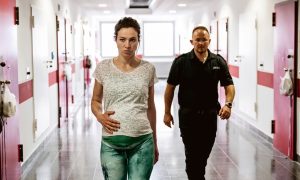It’s a rare opportunity nowadays at almost any big international film festival to watch a substantial slate of national cinema, such as the “New German Cinema” program in FilmFest Munich. So to seek patterns trying to understand what German cinema is right now was almost a critical reflex.
It’s only natural that the program treats the “national cinema” question according to industrial standards more to than anything else, which makes production the main criterion of film’s attribution. This principle, of course, widens the scope of what “German cinema” is,making it possible to include, for instance, a film such as Empty Nets (Leere Netze) which, by almost any other standard would be considered Iranian. Aside from clashes between cultural/industrial definitions, there was an example when the production prerogative indeed makes complete sense as an attribution standard because, paradoxically, the film strives for an international audience (it was filmed in English). The Dive, a white-knuckles-survival film with a time-limit, gnaws its backstory to almost bare bones to become an unstoppable thrill ride. This is a very entertaining film and it has enough production value to be a strong competitor on the market, even though it is a remake of a Swedish film, Breaking Surface (2020). Historically, “national” and “popular” cinema were treated as almost opposites,: The first was usually responsible for dominant historical narratives of national cinema, the second, to put it frankly, was sneered at. However, such production cases, especially when successful, often become the object of pride by national film industries, and rightly so.
While also shot in English, Franz Müller’s Diaries of Adam and Eve (Die Tagebücher von Adam und Eva), has a very different aim from The Dive. As the name implies, it is an adaptation of short stories by Mark Twain, who reimagined a biblical story in an ironic piece about gender roles. Müller’s picture is more of an arthouse, niche film, and even such a specific audience may find enduring. The fact that it was shot in English seems more a nod to its literary source than adding to its global appeal. Both The Dive and Diaries of Adam and Eve are placed in basically a social vacuum, first as a logical extension of global tourism, and the second by creating a decorative space to ruminate on an outdated outlook on gender roles.
English is heard in many other films in the program but not as a choice of a linguistic medium, and instead , in order to provide a middle ground for characters that come from all over the world. In fact, German films seems much more consistent in mirroring the reality of modern Europe or, at least, it represents itself this way [than any other national cinema] (the most characteristic film of this trend is Boyz, an observational but unfortunately not very observant documentary focusing on a few university students in Munich ). Language in such cases is more of a tool than a sign of identity. The only possible exception is Salty Water (Südsee). It is set in a suburban house in Israel, the hosting place for an art-residence of a recently arrived young German woman. Her companion, whose function is deliberately ill-defined is a Jewish young man. They speak English as well as German but only the latter means something that goes along with the history and culture beside it.
At first it seemed pointless to seek consistent themes in films that are just an instant snapshot of German cinema, but already quite early in the festival I started to think that there may be some truth to it. Half of the fiction films in the program somehow revolved around the themes of law and crime, and all of them featured at some point representatives of the law. All of them were either quite direct, and even didactical, or implicitly used clashes with the law to question social structures that, ideally, must be represented by the law system, leaving an impression that societal confusion lies at the core of all these films.
One of the most obvious examples is More Than Strangers, the film about a group of people who share a car during a ride from Berlin to Paris. One of them, as it turns out, is an illegal immigrant, who goes to Paris to obtain legal papers through a marriage of convenience. This fact with police after them, and all sorts of hindrances, turn the film into a series of tests for its characters, who must face ethical choice along the ways: to be egoistic and lawful or to be sympathetic, helping the person regarded as a criminal by a state even in the face of heavy repercussions. The film’s content almost never goes beyond the one-dimensionality of the choices. Its final twist, of course, makes much sense and could be rightly called smart but that still leaves us with the film itself.
Moral choices are at the center of perhaps the most straightforward social film in the whole program. Black Box seems to be a film about disintegration of civic society, which came at the cost of inflation of individuality. Its characters, inhabitants of the same house in a Berlin neighborhood, one by one become victims of machiavellian games by the new proprietary manager tasked to renovate the dilapidated building, and then rent apartments at higher prices. “It’s none of my business” attitude and the subsequent failure to unite and to resist collectively is pretty straightforwardly put as the main cause of everybody’s loss. Interestingly enough, law enforcement in this film provides unity of place and time, so to speak. For unknown reasons, the house and its courtyard where the action takes place, become cordoned off by the police. This provides (how conveniently) an opportunity for the main antagonist to divide and conquer every tenant, and to condition every one of them to his needs. Employing the idea that, in theory, there must be a thin blue line between good and bad, police in Black Box is a rather blunt, prejudicial force that maintains power structures, since they know how to use this force and are keen on it.
The idea of the law that fails to protect those in need is also at the center of It’s Burning (Es brennt), the tale of a happy German family of Arab descent, living their quiet, serene life until a hate-crime incident forces its members to repeatedly go to court, while the person who abused them on racist grounds continues to appeal. Even though the system of appeal per se cannot be called a legal defect, this case creates a dilemma that makes one understand why even German citizen of non-European descent are reluctant to go to the police when met with xenophobia and racism.
Films in the next block clearly avoid being as heavily didactic as the previous two, and strive instead to tell more individual stories, though always in a social context. Monster Inside (Monster im Kopf) and Shock (Schock – Kein Weg zurück), despite all their contrasting differences, seem like two sides of the same coin. Both films could be called psychological studies of characters going through the most strenuous ordeals. Both lean heavily on very strong performances by the lead actors. Monster Inside is the story of a woman in advanced stages of pregnancy, who is going to give birth in a prison maternity ward, while the story of her crime is told primarily through flashbacks. The main character of Shock is a doctor who lost his medical license, due to some unspecified drug abuse problems in the past, but who continues to be practicing illegally, helping those who can’t go to the hospital. When he agrees to treat a cancer patient who happens to be an Italian mafia boss, things go from from relatively bad to infinitely worse Both films seem inclined to tell individual stories, reluctant to give social backgrounds of the characters, or their backstories. They are stories of people who, even though still responsible for their actions, were pushed to the social or psychological margins, due to the nature of social and gender structures.
Dead Girls Dancing has all ingredients to be a horror film. Sometime after the first half an hour of the film three school grads from Germany and their new friend find themselves in the Italian village, which seems to have been abandoned only hours before they arrived. The four young women, of course, didn’t happen to be in the remake of some Euro-horror flick of 70s, such as The Vampires Night Orgy (La orgía nocturna de los vampiros), and all inhabitants are not vampires who wait until sundown to feast upon the living. The film obviously aims to place its characters in a human-made environment, but without people, social norms, obligations or parental guidance, and then to release all tensions, and to reveal things that were hidden. Clashes withthe law and the police are just an inevitable result of one of the girls shaping that almost leads to a tragedy. And again, similarly to Shock and Monster Inside, this film poses itself very much as e an isolated story, and almost too shy (but not entirely) to tell us more where this particular pressure point that caused the snapping is situated. Somewhere between being over-indulgent and bravely diving into whatever comes, moody and atmospheric, Dead Girls Dancing is one of the most interesting films in the program, due to the same characteristics that make it so uneven.
FIPRESCI prize went to Fossil, a film that didn’t fit any of the aforementioned patterns, and differed drastically from every other film in the program. It is shot completely in German,uninterested in the questions about morality of law, or the social nature of crime. Interestingly, some of its characters still clash with the law and the law itself here is used to maintain the old power structures, but Fossil is never interested in the process itself, only in repercussions. Even stylistically, this dry comedy is different, since it is shot in controlled and detached manner, and pays much more attention to intricate mise-en-scenes. Unlike almost every other film that struggles with combining the social and the individual dimension, Fossil combines them in its very premise: the biggest open mine in Europe, where the main protagonist worked all his life, gets attacked by an environmentalist group led by his daughter. It is a story of generational conflict within a nuclear family, but, at the same time, a capsule version of ideology battles we see every day on a much bigger scale. The film manages to never lose its dual focus, stressing throughout the conflict’s numerous, often hilarious contradictions.
Serhii Ksaverov
Edited by Ela Bittencourt
© FIPRESCI 2023



